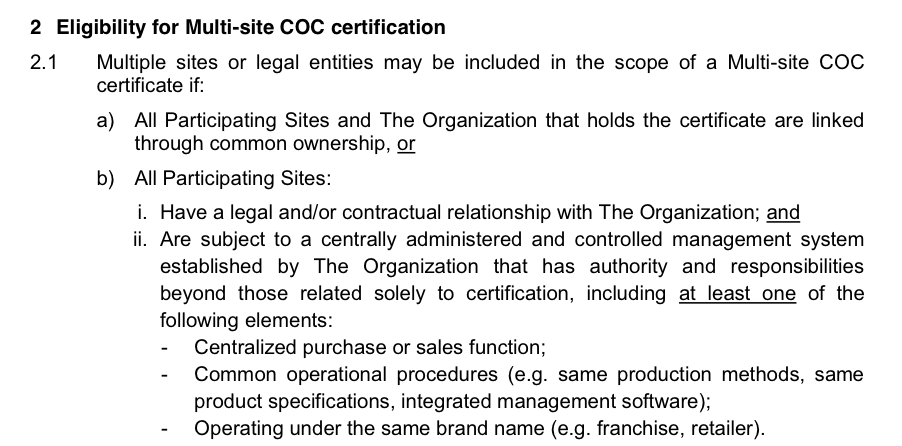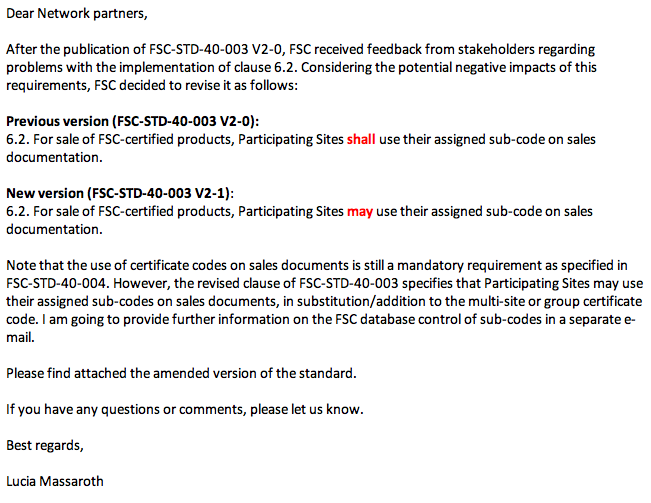 The Forest Stewardship Council (FSC) published the latest update to its standard for Multi-site Chain of Custody certification (FSC-STD-40-003 v.2-0) earlier this fall. It became public during the busy time just before the General Assembly, when FSC was also making interesting and important announcements about the fate of its Online Claims Platform (OCP) initiative and related commentary about “gaps” in the Chain of Custody program. Most industry watchers – including MixedWood – gave it little attention until recently.
The Forest Stewardship Council (FSC) published the latest update to its standard for Multi-site Chain of Custody certification (FSC-STD-40-003 v.2-0) earlier this fall. It became public during the busy time just before the General Assembly, when FSC was also making interesting and important announcements about the fate of its Online Claims Platform (OCP) initiative and related commentary about “gaps” in the Chain of Custody program. Most industry watchers – including MixedWood – gave it little attention until recently.
The Multi-site standard is possibly the least exciting of FSC’s family of CoC standards. It consists of a series of technical and administrative requirements that allow large companies to acquire and maintain certificates which cover a number of separate, but interconnected business units. This might include several manufacturing plants owned by a corporation, or possibly a network of distribution warehouses. Economies of scale provide cost savings and allow an integrated corporation the ability to manage its business from a central office under a single certificate. The update to the current multi-site standard (STD-40-003 v.1-2) had been in the works for several years. When it was finally released this year, it came as no surprise (or so we thought). It is due to be fully implemented quite soon (1 January 2015), so many folks are looking closely at its details right now. Many of them are realizing that the new standard contains a surprise after all. An important item that is only now being recognized as a problem.
Looking at the details
Multi-site Chain of Custody (CoC) is commonly applied in large, integrated corporations. These are the kind of companies which have highly centralized business functions. This was clearly the intent of the standard, as we can see below in the section concerning Eligibility (Section 2):
Three items catch our attention in this excerpt: Multi-site companies are expected to have a “centrally administered and controlled management system”, “centralized … sales function(s)”, and “integrated management software”.
To find the problem lurking in the new STD-40-003, we must look a bit further, to the section which defines implementation requirements for participating sites (Section 6), excerpted here:
Clause 6.2 introduces a new and apparently simple requirement for participating members of multi-site companies to make use of “assigned sub-code(s)” on their sales documentation. What exactly is a sub-code? And why does the use of sub-codes on sales documentation present a problem? Some explanation is needed.
The Problem With Sub-codes
When a company becomes CoC certified, they acquire a certificate which is identified with a unique, identifying code. Commonly referred to as “certificate numbers” or “CoC numbers”, they are referenced in the FSC system as “CoC codes”. The CoC standard requires that these codes be used to identify a certified company. Importantly, this happens at the point of sale when CoC codes are used on sales documents (invoices, etc.) to identify and trace CoC certified products.
We can quickly see an example of a CoC code by looking up a certified company on the central FSC certificate database. We can start with a simple example: the FSC database record for Rough & Ready Lumber. We have no connection to this company (we just like the name). They are a good example of a single-site certificate. Right at the top of the database record we find: “Certificate Code: SCS-COC-002333”. Scroll down to the section labeled “Group member/sites” and we find no entries. This company has no need for the multi-site standard or for sub-codes.
To find a good example of a multi-site company, please click this link for the FSC database listing for Xpedx. Xpedx is a well-known, and very large paper distribution company. As with our first example, we can find their certificate code (BV-COC-0061203) listed at the top of the page. Scroll down, however, and we find a very large section under the heading “Valid Group member/sites”. We see that Xpedx does business from over 130 individual locations across the United States. At the left side of the site listing, we see that each site is identified with a unique sub-code.
Xpedx is simply a good example of a large, certified, multi-site company. Anyone who buys and sells paper commercially in the USA or Europe is familiar with their style of business – a style that is common across the entire industry. They are a classic example of a “centrally administered and controlled management system”, with “integrated management software”, “centralized purchase (and) sales function(s)”. Companies like this control a very large portion of the market for certified paper and wood products around the world. Most of them have just recently taken a close look at the new STD-40-003 and many of them are alarmed.
Integrated, automated, and centralized business systems are very good at providing efficient and streamlined transactions and production controls. They are also famously inflexible and expensive to customize. We know from experience that it took years, and uncounted thousands of dollars, for many large, integrated companies for incorporate efficient and reliable systems to provide required CoC information into their sales documents. This new sub-code requirement promises to introduce another layer of complexity on top of this already-complex process. This result is guaranteed to be create havoc. It could be a practical impossibility for some companies. For others, the cost will be enormous. The net result, in any case, is bound to be chaotic and very, very expensive.
Why?
It is very clear that the new “sub-code” requirement cannot be implemented into the existing CoC system without causing enormous cost and disruption. What is not clear is whether the new requirement really adds any value to the standard. The industry folks that we have spoken to recently are all agreed on this point: adding sub-codes to sales transactions adds cost without adding value. Other FSC stakeholders and staff may disagree, of course. But if they do, they should explain themselves quickly. Is this related to the planned (and now deferred) implementation of the Online Claims Platform? Or perhaps a well-intentioned (& perhaps mis-guided) attempt to close the mythical “gap” that some think threatens the FSC program. Whatever the case, some transparent discussions are needed right away.
A Solution in the Works?
MixedWood has been told that a discussion is ongoing among FSC-US staff and several of the larger Certification Bodies (CB’s). There seems to be a practical recognition that implementation of STD-40-003 v.2-0, as currently written, could lead to a disaster. Our hope is that a practical solution is in the works.
UPDATE (13 Nov. 2014):
Several correspondents responded promptly to this post with some new and helpful information. Here is what we have learned or confirmed:
- An active discussion about the implementation of multi-site sub-codes has been underway for several weeks between staff at FSC-IC and a number of Certification Bodies (CB’s).
- FSC-IC some practical IT implementation troubles in their database – unresolved at this date, but apparently straightforward.
- The sub-code requirement of Clause 6.2 was, in fact, added to the new multi-site standard to facilitate implementation of the OCP.
- FSC-IC has received negative feedback from multi-site companies about the cost and complexity of implementing Clause 6.2 and circulated a request to CB’s for more information on the subject.
UPDATE (19 Nov. 2014):
FSC appears to have taken very quick action on this issue. Good for them. Here is some communication that was circulated today:


